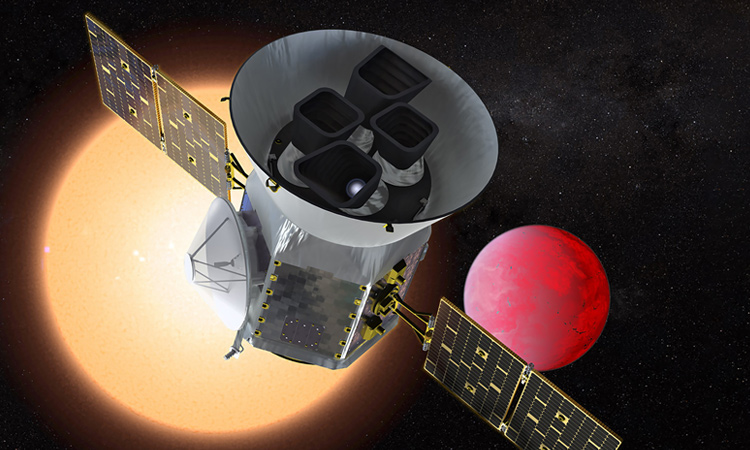 An artist’s rendering of TESS in space shows the hoods on its four cameras and two deployed solar array wings that provide the satellite with 415 W of power. [NASA Goddard Space Flight Center]
An artist’s rendering of TESS in space shows the hoods on its four cameras and two deployed solar array wings that provide the satellite with 415 W of power. [NASA Goddard Space Flight Center]
For much of humankind’s existence, we believed Earth to be the only planet with life. We were alone in the universe, special and unique. In the last few decades, however, the sheer number of extrasolar planets, or exoplanets, discovered orbiting faraway stars has challenged that belief.
The golden age of exoplanetary studies began in the early 1990s with the discovery of two exoplanets in orbit around the millisecond pulsar PSR B1257+12, a neutron star that rotates 9,650 times per minute. These two “super-Earths” were roughly four times Earth’s mass (4 M⊕ , where M⊕ = 1 Earth mass). The conditions around neutron stars make such planets unlikely candidates to support life as we know it. More and more exoplanets popped up in planetary surveys, many of them large gas giants like Jupiter, until exoplanets by themselves were no longer very newsworthy.
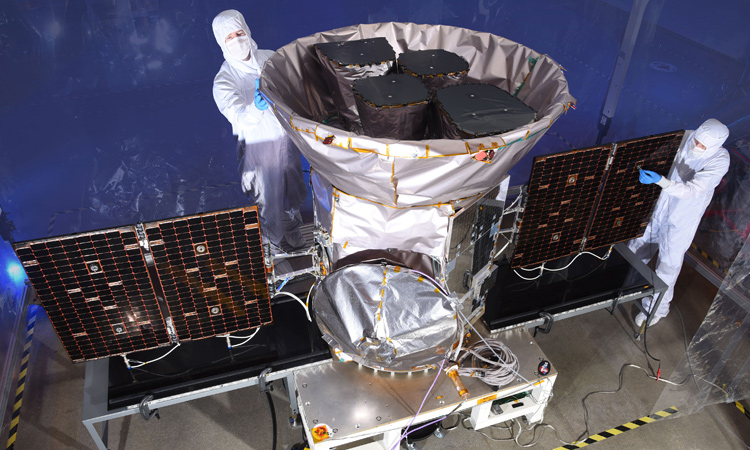 The fully integrated Transiting Exoplanet Survey Satellite (TESS). [NASA]
The fully integrated Transiting Exoplanet Survey Satellite (TESS). [NASA]
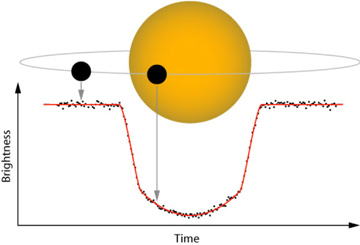 The transit method of exoplanet detection identifies a planet when it crosses the face of a star, temporarily dimming its light. [NASA]
The transit method of exoplanet detection identifies a planet when it crosses the face of a star, temporarily dimming its light. [NASA]
Chasing Goldilocks
Then, in 1995, astronomers Michel Mayor and Didier Queloz at the University of Geneva, Switzerland, identified 51 Pegasi b, a hot gas giant and the first exoplanet found orbiting a main-sequence star like the sun—a discovery that earned the pair half of the 2019 Nobel Prize in Physics. In 1999, an international team of astronomers in the United States and Australia observed a multiple-planet system orbiting a sun-like star, the first confirmation of a solar system beyond our own. Since then, many exoplanets have been discovered that fall within a star’s habitable zone, or “Goldilocks zone”—the orbit for which conditions are just right for the existence of liquid water and, by extension, possible life.
The Kepler Space Telescope, named for the 17th-century German astronomer who cracked the code of planetary motion, was launched in 2009 to survey a small region of the sky in great detail to find exoplanets. Kepler’s role was to continually monitor about 150,000 stars for brightness fluctuations that might be caused when exoplanets cross in front of, or transit, the face of their host star. Such transits are rare and occur only in systems with orbits that are plane-perpendicular to the observer. Nonetheless, in its nine-year lifetime, Kepler identified some 5,000 candidate planets around faraway stars, more than 2,500 of which have now been verified by other observations.
Exoplanet detection basics
The faint signal of light from extrasolar planets is typically lost in the glare of their parent stars, making them intrinsically challenging to resolve directly. Astronomers have identified over a dozen techniques of detecting exoplanets indirectly. Here are some of the most successful ones.
Pulsar timing. For planets orbiting pulsars, slight, eccentric variations in the pulse timing of the parent neutron star can indicate planets exerting a gravitational tug on the star.
Astrometry. This method involves directly observing the star’s subtle transverse gravitational “wobble” motion, attributable to an orbiting planet. It will be used (along with direct imaging) by the 6.5-m James Webb Space Telescope, scheduled for launch in 2021.
Doppler spectroscopy, or radial velocity. The gravitational pull of a planet on its parent star as the two orbit their common center of mass causes apparent back-and-forth motion of the star along the line of sight. The absorption lines within the star’s spectrum are blue-shifted as the star approaches and red-shifted as it recedes in its tiny “orbit.” This technique, the most common used to identify exoplanets before Kepler, enables measurement of planetary orbital periods and the lower limit of planetary masses.
Transit photometry. This technique, used by the Kepler Space Telescope and TESS, requires observation of a planet transiting directly across the face of its parent star, which causes a temporary drop in the star’s brightness. Such transits are rare and require an edge-on view, but the method enables an unambiguous determination of a planet’s orbital period and radius. With additional spectroscopy, the planet’s mass, and hence its mean density and likely composition, can be estimated.
Transit spectroscopy. If the parent star is bright enough, spectroscopy can reveal information about a planet’s atmosphere, if it has one. As the planet passes in front of its parent, its atmosphere absorbs some of the starlight; the resulting black absorption lines on the spectrum can reveal the characteristic patterns of certain atmospheric molecules, such as hydrogen, helium, nitrogen and oxygen.
Based on Kepler Space Telescope observations, astronomers have concluded that perhaps 20% to 50% of stars visible to the naked eye from Earth probably have Earth-like planets.
NASA retired Kepler on 30 October 2018, when the spacecraft ran out of fuel. But the satellite revealed the sparkling diversity of planets and of the types of stars that have them. Based on Kepler’s observations, astronomers have concluded that perhaps 20% to 50% of stars visible to the naked eye from Earth probably have Earth-like planets, and that as many as 40 billion Earth-sized planets may be orbiting in the habitable zones of suitable stars in the Milky Way galaxy.
“We know [Kepler’s] retirement isn’t the end of its discoveries,” said Jessie Dotson, Kepler’s project scientist at NASA’s Ames Research Center in Mountain View, CA, USA. “I’m excited about the diverse discoveries that are yet to come from our data and how future missions will build upon Kepler’s results.”
Enter TESS
And build they will. In April 2018, Kepler passed the torch to a new space telescope, the Transiting Exoplanet Survey Satellite (TESS). Smaller and lighter than Kepler, and with a very different layout (consisting of four refractive cameras, rather than a single meter-class reflecting telescope), TESS also cost less than Kepler to build (US$200 million versus US$640 million). But it has a big job. A team led by the Massachusetts Institute of Technology (MIT), USA, designed TESS for a two-year mission to scour the entire sky for transiting planets. Whereas Kepler stared at one region of the sky for many years, TESS is an all-sky survey using a “stare and step” technique with a field of view (FOV) twenty times larger than Kepler’s.
Why make that search, if NASA’s Kepler mission has already identified enough exoplanet candidates to keep astronomers busy for decades? The thousands of exoplanets that Kepler discovered mostly orbit dim stars—below 12th magnitude (brightness decreases as magnitude increases) and more than 1,000 light years away from Earth—and range from Earth-sized to Jupiter-sized planets. Kepler focused on identifying sheer numbers of exoplanets, to characterize the type of stars that have planets around them and to provide broadly useful statistics for astronomers.
TESS takes the next logical step beyond Kepler, observing brighter stars approximately ten times closer, on average, than Kepler’s targets.
Kepler discovered that exoplanets the size of Earth and larger are abundant in the galaxy, and have a wide variety of masses, orbits and compositions. Confirming these candidate exoplanets will require more observation—but, with the vast majority of Kepler’s target stars so faint, a detailed follow-up of their planet candidates will be difficult with existing telescopes. (In fact, you’d need telescopes ten times larger than the next-gen extremely large telescopes now in the pipeline to confirm most of Kepler’s faintest candidates.)
TESS takes the next logical step beyond Kepler, observing brighter stars approximately ten times closer, on average, than Kepler’s targets. Of particular interest are the planets ranging in size between that of Earth and that of Neptune, because our solar system has none like that. TESS’s primary mission is to identify objects on average closer than 100 parsecs (around 326 light years) away.
Transit schedule
TESS will also revisit targeted planet candidates observed by Kepler at just the right time to accurately confirm their long-period orbits. Kepler followed the same targets in the same FOV for several years, observing exoplanets over several revolutions to precisely characterize their orbits. Because the observed duration of a planet transit is only around 0.1% of its orbital period, it would be easy to miss a transit if the planet’s orbit and predicted time of transit were not accurately known. TESS aims to re-measure the times of transit for certain bright candidates that Kepler identified years ago, to pinpoint the times of their future transits, even as it nails down the transit timing for the nearby planets that TESS itself discovers.
In this way, TESS can refine the orbital periods of strong exoplanet candidates for other telescopes to more precisely target down the line. This is important because astronomers have to tightly schedule observations on large, research-grade telescopes to fully utilize their high-resolution, deep-sky capabilities. Rather than staring at a given object for one or two days to observe a transit, large telescope schedules are tightly optimized to turn to a target at just the right moment and not waste telescope time.
In the first 19 months since deployment, TESS researchers identified several exoplanet candidates 6 to 10 parsecs (roughly 20 to 30 light years) away that will be relatively easy to confirm with the next generation of extremely large segmented-design telescopes. These include ground-based behemoths like the 24.5-m-diameter Giant Magellan Telescope, now under construction in Chile; the Thirty Meter Telescope, scheduled for construction on Mauna Kea in Hawaii since July (but delayed by cultural protests); and the 40-m European Extremely Large Telescope, now under construction in Chile and expected to begin operations in 2025.
The large ground-based telescopes can perform follow-up imaging on transit targets to discriminate exoplanets from brown dwarfs and binary stars, using adaptive optics to remove distortions from Earth’s atmosphere. High-resolution space telescopes like the 6.5-m James Webb Space Telescope, planned for deployment in 2021, will be able to confirm numerous parameters of TESS’s targets of interest (TOIs) using visible and infrared spectrographs, which require vastly more photons than TESS did for its initial transit detections.
 Modeling suggests that one of the exoplanets around the young red M-dwarf star GJ 357, about 30 light years from Earth, lies in the star’s habitable zone and could have conditions similar to those on a young Earth. [Jack Madden/Cornell University]
Modeling suggests that one of the exoplanets around the young red M-dwarf star GJ 357, about 30 light years from Earth, lies in the star’s habitable zone and could have conditions similar to those on a young Earth. [Jack Madden/Cornell University]
Public treasure: TESS data
According to George Ricker, TESS principal investigator and director of the CCD Laboratory at MIT’s Kavli Institute for Astrophysics and Space Research, TESS is more than just an intermediary between Kepler and Webb. “Because we designed the mission to study exoplanets in the local solar neighborhood, TESS’s targets are much closer and brighter than Kepler’s. The spectra that Webb will obtain in follow-up will thus be bright enough to provide information about the exoplanets’ atmospheric composition in reflected light, not just in broadband absorption during a rare and brief transit. So future studies will tell us much more than we expected about the atmospheres of those planets.”
Any reporting of the statistics surrounding TESS discoveries becomes dated the moment it’s printed, as the mission results in new candidate planets and research papers every day. TESS is racking up two or three TOIs per day. It’s expected to have identified over 1,400 TOIs through year-end 2019, and to have lent its data to more than 200 published papers in 2019 alone. Last August, NASA announced a two-year extension of the TESS mission, allowing the satellite to continue collecting planets through 2022, and the TESS team expects the satellite to discover several hundred more transits in the next several years.
Typically, satellite science teams have the rights to claim exclusive proprietary access to observations for an extended period, even years. Because of the vast number of images that its cameras are collecting, however, the TESS team knew that it would need help analyzing the huge data volumes (two petabytes per year, according to Ricker) that TESS would handle. So the team streamlined the time it takes to make the data publicly available down to about two months—faster than any other mission in NASA history.
When designing TESS, the team understood that storing and downloading this data trove would pose challenges. Whereas Kepler could transmit its data down to Earth at a 4 Mbps data rate from its Earth-trailing orbit, TESS’s highly elliptical orbit enables a very close perigee (near-Earth) passage, during which the satellite can transmit at 100 Mbps. As a result, TESS can produce as much data in five months as Kepler did in nine and one-half years. The public availability of this amount of survey data has enabled an explosion in the rate of exoplanet research results.
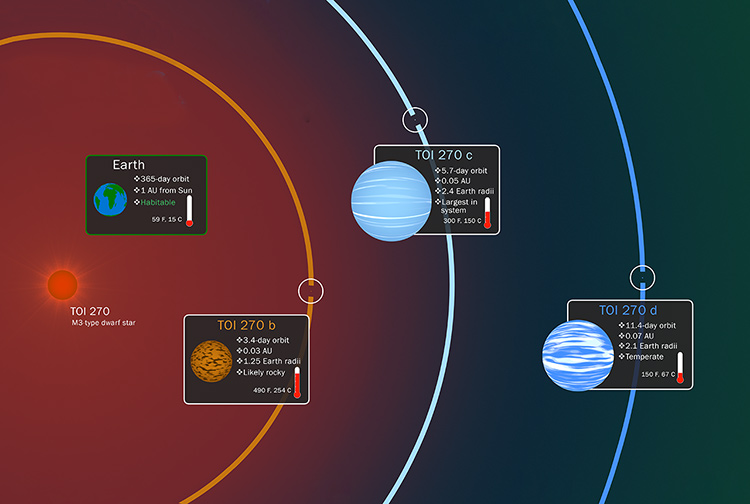 TESS discovered three transiting exoplanets around the M dwarf star TOI 270—one slightly larger than Earth and two of a type not found in our solar system. [Infographic by Scott Wiessinger/NASA Goddard Space Flight Center] [Enlarge image]
TESS discovered three transiting exoplanets around the M dwarf star TOI 270—one slightly larger than Earth and two of a type not found in our solar system. [Infographic by Scott Wiessinger/NASA Goddard Space Flight Center] [Enlarge image]
New discoveries
Notable TESS discoveries so far include a system of three planets around GJ 357, a cool M-dwarf star only 9.4 parsecs (31 light years) away in the Hydra constellation. An international coalition led by Cornell’s Lisa Kaltenegger, associate professor of astronomy and director of the Carl Sagan Institute, reported in July 2019 that one of them is the first TESS discovery of a potentially habitable world outside our solar system. The planet GJ 357d is a super-Earth (6M⊕) orbiting its parent star every 56 days in the habitable zone, at a location comparable to that of Mars.
Several models suggest that GJ 357d is likely a frozen rocky world with an average temperature of –64 °F. But one model found that if the atmosphere were thick enough to retain heat, the harsh radiation coming from the young red sun could warm it sufficiently to support liquid water on the surface. The amount of radiation would be high, but akin to that on the young Earth. “And on a young Earth, we had life,” said Kaltenegger. “So the chances of finding life around the closest young, red stars just got a little better.”
TESS also discovered a system of three Earth-size planets around the bright M dwarf L 98-59, which lies 10.6 parsecs (35 light years) away. The planets range in size from 0.8 to 1.35 and 1.59 times the Earth’s radius, with orbital periods of 2.25 days, 3.69 days and 7.45 days, respectively. The innermost planet, L 98-59b, is the smallest planet yet detected by TESS. Any measurement of habitability is extrapolated from our understanding of the Earth and therefore Earth-centric, but all three of the planets seem unlikely candidates to host life, as each would probably receive a higher flux of radiation than the Earth does from the sun. (TESS later scored still another “hat trick,” finding three planets—one only 25% larger than Earth—around M dwarf TOI 270.)
While an Earth analog has yet to be found, an array of exoplanets beckons for follow-up observations to bring a deeper understanding of the potential for life.
While an Earth analog has yet to be found, a tantalizing array of exoplanets beckons for follow-up observations that will bring a deeper understanding of atmospheric conditions and the potential for life. And TESS has provided fundamentally new data that can illuminate unexpected areas of astronomy, including asteroseismology studies of main-sequence stars, oscillations of white-dwarf stars, supernova explosions, and tidal disruptions of stars that venture too close to massive black holes in the nuclei of distant galaxies.
“We now have available all kinds of information that is absolutely brand new,” said Ricker. “The stars themselves are providing information that nobody has ever really had a clear picture of. Some stars are ringing in resonant waves; some have oscillations that grow and die; some undergo disruptive explosions resulting in their violent death. It’s a very exciting, rich new field of time-domain astronomy.”
Adds Kaltenegger: “TESS is our small mighty mission that could. It has uncovered the hidden planets orbiting the stars we see every night. It is changing the way we see the night sky.”
[Editor’s note: As this article was going to press, NASA reported that TESS had discovered its first Earth-sized planet located in its star’s habitable zone.]
Valerie C. Coffey is a freelance science and technology writer and editor based in Indio, CA, USA.
References and Resources
-
A. Wolszczan and D.A. Frail. Nature 355, 145 (1992).
-
R.P. Butler et al. Astrophys. J. 526, 916 (1999).
-
G.R. Ricker et al. J. Astron. Telesc. Instr. Syst. 1, 014003 (2015).
-
A. Patruno and M. Kama. Astron. Astrophys. 608, A147 (2017).
-
V. Kostov et al. Astron. J. 158, 32 (2019).
-
L. Kaltenegger et al. Astrophys. J. 883, 2 (2019).

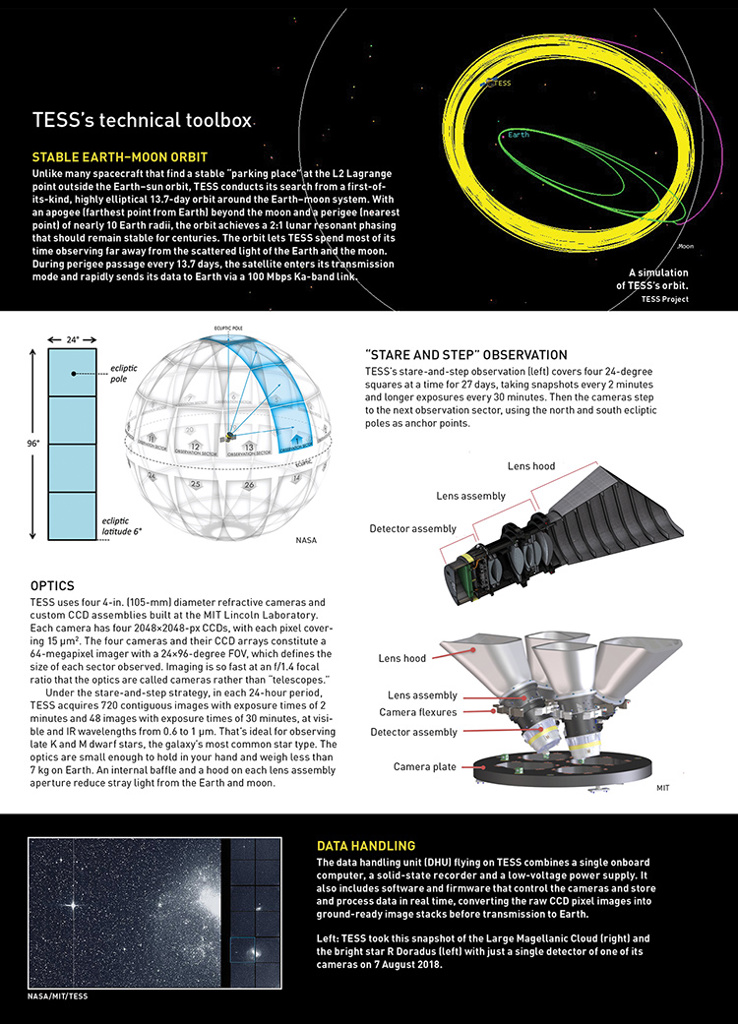 [
[